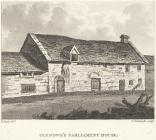Owain Glyndŵr
Items in this story:
Childhood
No name in the history of Wales is more recognisable than Owain Glyndŵr. Despite this, most of his life is a mystery. For example, no-one is exactly sure when he was born; there are three possible dates: 1349, 1354 and 1359. But one thing is certain: he was born to a rich family and an important lineage.
His father, Gruffudd Fychan II, was descended from Bleddyn ap Cynfyn, the ruler of Powys in the eleventh century, and his mother, Elen ferch Tomos ap Llewylyn, was descended from Rhys ap Tewdwr of Deheubarth. Taking this into consideration, along with the death of Owain Lawgoch, the last of the male descendants of Gwynedd in 1378, Owain Glyndŵr was the obvious choice to be Prince of Wales.
His family owned estates in Sycharth, Iscoed in the Teifi Valley which his mother inherited, and Glyndyfrdwy in the Dee Valley. It is believed Owain spent most of his childhood in Sycharth.
Links with England
Like many nobles in Wales, Owain was loyal to the English crown. He studied law in London, and was a member of King Richard II's army and fought on the border of Scotland and then in the Scottish and French campaigns of 1387.
In 1383 he married Margaret Hamner, a woman of Anglo-Norman descent from the family of the Lords of March, who arrived with Edward I over a century earlier. Her father, Sir Dafydd Hamer, was a lawyer in London, and this is probably the reason Owain went to study law.
In between his campaigns with the army, Owain lived a comfortable life as a country noble, and was in contact with a large number of the Marches nobles. So what was it that changed him from being a loyal subject of the crown and risk his high and respectable status by leading a revolt against England, and claiming the title Prince of Wales?
The background of the revolt
By the end of the fourteenth century, there were a number of things which were beginning to infuriate the Welsh. Taxes in Wales were higher than in England, and with peace with France, Welsh soldiers were out of work. The Welsh also suffered racial discrimination, especially in the world of commerce, and in appointments to key posts in the church and government. Many people in Wales believed they were exiles in their own country, and that they needed a leader.
As far as Owain Glyndŵr is concerned, there are several suggestions why the revolt began. There was a dispute between him and his neighbour Reginald de Grey over a piece of land. Reginald de Grey was Third Baron Grey of Ruthin and Earl of Chester; he belonged to the Lords of March which separated England and Wales during Edward I's reign. The case went all the way to parliament in London, but Owain was unfairly treated because he was Welsh, and the case was refused. Glyndŵr's problems increased when de Grey used his status to blacken his name. He managed to trick Owain by preventing a call to join the new king, Henry IV's, campaign in Scotland in 1400. This was considered treason, especially as Glyndŵr had been so loyal to the previous king.
Whatever caused the revolt, on 16 September 1400 Owain Glyndŵr was crowned Prince of Wales, and two days later Ruthin was razed to the ground, with many other towns in the north-east receiving the same treatment in the days which followed. By 26 September, Henry IV's army had reached Shrewsbury, and by the beginning of October had reached Bangor in north-west Wales. Owain Glyndŵr and the Welsh had disappeared into the mountains and were using guerilla tactics, which is how the revolt lasted as long as it did.
1400-1410
This is the decade of Owain Glyndŵr's revolt, which began as he was crowned Prince of Wales in 1400. He catured Conwy castle in 1401, and won the Battle of Hyddgen.
The revolt reached its peak between 1403 and 1405, throughout Wales. English-owned castles and houses throughout Wales were attacked. In 1402 Carmarthen castle was captured, and Abergavenny and Usk castles were attacked. Cardiff and Chepstow castles were captured.
In 1403 Caernarfon castle was attacked and was nearly taken. In 1404 Cricieth, Harlech and Aberystwyth castles were captured. During the same year, Glyndŵr's Parliament was held in Machynlleth with four men, one from each part of Wales. Agreements with France and Spain were drawn up, and Owain Glyndŵr was crowned King of Wales. French troops landed in Milford Haven and joined Glyndŵr's army.
The second parliament was held the following year, and Glyndŵr's idea of splitting Wales and England into three parts was discussed. Mortimer would have the south and the west, Thomas Percy, Earl of Northumberland, would have the middle and north, and Owain himself would have Wales and the Marches. On 31 March 1406, to ensure extra help from France, Glyndŵr wrote a letter to King Charles VI from Pennal near Machynlleth. This is the famous Pennal Letter. In the letter Owain agrees to transfer the obedience of Welsh churches from the Pope in Rome to the Pope in Avignon. He did not receive a reply to the letter.
Things went from bad to worse in 1408, when the English king captured Aberystwyth and Harlech castles, and Glyndŵr's family were imprisoned. Owain and his son Maredudd and others were forced to flee. There is not much information on Owain after this: he is named for the last time in parliamentary records in February 1416, but it is believed that he had already died by then. There is no record of his death, or where he was buried.


